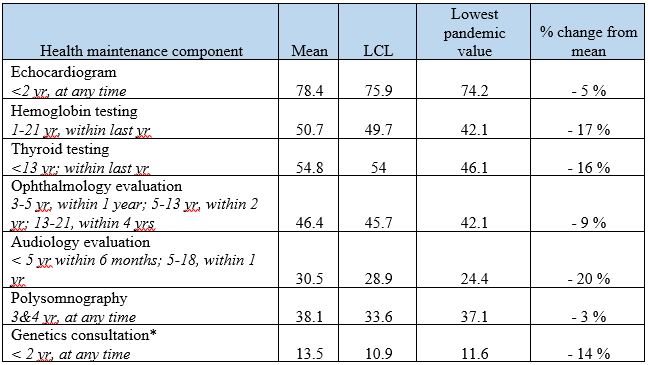General Pediatrics: Primary Care/Prevention
Category: Abstract Submission
General Pediatrics V
103 - Decreased Delivery of Care to Patients with Down Syndrome during the COVID-19 Pandemic
Monday, April 25, 2022
3:30 PM - 6:00 PM US MT
Poster Number: 103
Publication Number: 103.409
Publication Number: 103.409
Bradley Phillips, San Antonio Uniformed Services Health Education Consortium, San Antonio, TX, United States; Madison Marvel, San Antonio Uniformed Services Health Education Consortium, Converse, TX, United States; Gregory H. Gorman, Defense Health Agency, Takoma Park, MD, United States; David T. Hsieh, Uniformed Services University of the Health Sciences F. Edward Hebert School of Medicine, San Antonio, TX, United States; Michael Misurek, Booz Allen Hamilton, Fairfax, VA, United States
.jpg)
Bradley Phillips, MD
Resident, PGY3
San Antonio Uniformed Services Health Education Consortium
San Antonio, Texas, United States
Presenting Author(s)
Background: The COVID-19 pandemic lead to decreased access to care for pediatric patients, with multiple reports of decreased well visits, acute care visits, and immunizations. The pandemic especially affected access for vulnerable patient populations, including those with medical complexities such as Down Syndrome (DS). Prior to the pandemic, there were poor rates of adherence to the American Academy of Pediatrics (AAP) health supervision guidelines for children with DS; published baseline adherence rates range from 10-56% depending on the health component studied.
Objective: We aimed to determine how the COVID-19 pandemic affected the delivery of seven key components of health screening and surveillance for patients with DS.
Design/Methods: We used the Military Health System (MHS) data repository to capture the care of over 1.3 million child beneficiaries receiving care in both military and civilian facilities. Patients aged 0-25 years with DS were identified through ICD-10 codes. We defined on-time and up-to-date delivery of 7 AAP components including genetic counseling consultation, hemoglobin testing, thyroid stimulating hormone (TSH) testing, polysomnography, echocardiogram, audiology evaluation, and ophthalmology evaluation using a combination of procedural, laboratory, and Provider Taxonomy codes. Iterative chart reviews refined definitions, including inclusion criteria; the genetic consultation definition had a major re-definition in Sep 2021. Control charts, with mean, upper control (UCL), and lower control lines (LCL) calculated from October 2019 through March 2020, displayed measures monthly.
Results: The population ranged between 2691-2877 patients enrolled at 138 clinics, including 7 clinics overseas. Rates of completing each of the seven health screening components had negative shifts below the mean soon after the start of the COVID-19 pandemic in March 2020; five measures shifted below the LCL (Figure 1). More frequent screening components such as annual hemoglobin had more significant decreases for a sustained period of time than other components which require a onetime consultation such as an echocardiogram. The maximum percent decrease from the pre-pandemic mean ranged from 3% to 20% depending on the screening component evaluated (Table 1).Conclusion(s): Children with DS had decreased rates of completing routine recommended screenings and surveillance during the COVID-19 pandemic. This occurred in an open access, no-to-low-cost, universal health care system.
CV_Bradley PhillipsCV-2021_Phillips_Final.pdf
Table 1: Delivery of 7 Recommended Health Maintenance Evaluations for ~ 2800 Pediatric Patients with Down Syndrome *the definition of genetics consultation did not fully capture delivered care prior to Sep 2021, and may still undercount delivered care
*the definition of genetics consultation did not fully capture delivered care prior to Sep 2021, and may still undercount delivered care
LCL Lower Control Line; yr Year
Objective: We aimed to determine how the COVID-19 pandemic affected the delivery of seven key components of health screening and surveillance for patients with DS.
Design/Methods: We used the Military Health System (MHS) data repository to capture the care of over 1.3 million child beneficiaries receiving care in both military and civilian facilities. Patients aged 0-25 years with DS were identified through ICD-10 codes. We defined on-time and up-to-date delivery of 7 AAP components including genetic counseling consultation, hemoglobin testing, thyroid stimulating hormone (TSH) testing, polysomnography, echocardiogram, audiology evaluation, and ophthalmology evaluation using a combination of procedural, laboratory, and Provider Taxonomy codes. Iterative chart reviews refined definitions, including inclusion criteria; the genetic consultation definition had a major re-definition in Sep 2021. Control charts, with mean, upper control (UCL), and lower control lines (LCL) calculated from October 2019 through March 2020, displayed measures monthly.
Results: The population ranged between 2691-2877 patients enrolled at 138 clinics, including 7 clinics overseas. Rates of completing each of the seven health screening components had negative shifts below the mean soon after the start of the COVID-19 pandemic in March 2020; five measures shifted below the LCL (Figure 1). More frequent screening components such as annual hemoglobin had more significant decreases for a sustained period of time than other components which require a onetime consultation such as an echocardiogram. The maximum percent decrease from the pre-pandemic mean ranged from 3% to 20% depending on the screening component evaluated (Table 1).Conclusion(s): Children with DS had decreased rates of completing routine recommended screenings and surveillance during the COVID-19 pandemic. This occurred in an open access, no-to-low-cost, universal health care system.
CV_Bradley PhillipsCV-2021_Phillips_Final.pdf
Table 1: Delivery of 7 Recommended Health Maintenance Evaluations for ~ 2800 Pediatric Patients with Down Syndrome
 *the definition of genetics consultation did not fully capture delivered care prior to Sep 2021, and may still undercount delivered care
*the definition of genetics consultation did not fully capture delivered care prior to Sep 2021, and may still undercount delivered careLCL Lower Control Line; yr Year
